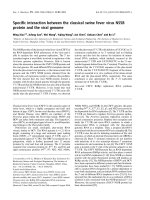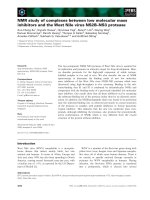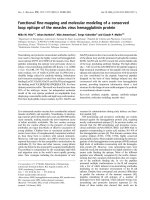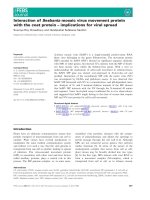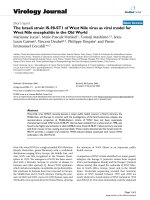Modulation of west nile virus capsid protein and viral RNA interaction through phosphorylation 1
Bạn đang xem bản rút gọn của tài liệu. Xem và tải ngay bản đầy đủ của tài liệu tại đây (15.95 MB, 44 trang )
i
MODULATION OF WEST NILE VIRUS CAPSID PROTEIN
AND VIRAL RNA INTERACTION THROUGH
PHOSPHORYLATION
CHEONG YUEN KUEN
(B.Sc. (Hons) University of Toronto, Canada)
A THESIS SUBIMITTED
FOR THE DEGREE OF DOCTOR OF PHILOSOPHY
DEPARTMENT OF MICROBIOLOGY
NATIONAL UNIVERSITY OF SINGAPORE
2010
|
i
PUBLICATIONS AND PRESENTATIONS GENERATED DURING THE
COURSE OF STUDY
Publications:
Bhuvanakantham, R., Cheong, Y. K. and Ng, M. L. (2010). West Nile virus capsid
protein interaction with importin and HDM2 protein is regulated by protein kinase C-
mediated phosphorylation. Microbes Infect 12, 615-625
Tan, L.C.M., Chua, A.J.S., Goh, L.S.L., Pua, S.M., Cheong Y.K. and Ng M.L.
(2010). A membrane chromatography method for the rapid purification of recombinant
flavivirus proteins. Protein Expression and Purification. [Epub ahead of print]
Manuscript Under Revision:
Cheong, Y.K. and Ng M.L. Dephosphorylation of West Nile virus capsid protein
enhances the processes of nucleocapsid assembly. Microbes Infect.
Conference Presentations (Oral):
Cheong, Y.K. and Ng M.L. (2009). Phosphorylation is a key modulator of flaviviral
capsid protein functions. Duke-NUS Emerging Infectious Diseases Symposium,
Singapore.
Conference Presentations (Poster):
Cheong, Y.K. and Ng M.L. (2010). Phosphorylation of West Nile virus capsid
protein is essential for efficient viral replication. 10
th
Nagasaki-Singapore Medical
Symposium on Infectious Disease, Singapore.
Goh, L.S.L., Tan, L.C.M., Chua A.J.S., Pua, S.M., Cheong, Y.K. and Ng M.L. (2009)
A membrane chromatography method for the rapid purification of recombinant flavivirus
proteins. Duke-NUS Emerging Infectious Diseases Symposium, Singapore.
Cheong, Y.K. and Ng M.L. (2009). The role of West Nile virus capsid
phosphorylation and its consequence in viral replication. 8
th
Asia Pacific Congress of
Medical Virology, Hong Kong.
Cheong, Y.K. and Ng M.L. (2008). Phosphorylation of West Nile virus capsid
protein attenuates its interaction with viral RNA. 14
th
International Congress of
Virology, Istanbul.
Cheong, Y.K. and Ng M.L. (2008). West Nile Virus capsid protein and RNA
interaction. 13
th
International Congress of Infectious Disease, Kuala Lumpur.
|
ii
Cheong, Y.K. and Ng M.L. (2008). Flaviviral capsid protein and RNA interaction. 1
st
Annual Singapore Dengue Consortium, Singapore.
Cheong, Y.K. and Ng M.L. (2007). Characterization of West Nile virus capsid
protein. 6
th
National Health Group Annual Congress, Singapore.
|
iii
ACKNOWLEDGEMENT
I would like to express my sincere gratitude to Professor Ng Mah Lee for the immense
amount of support and guidance she has provided throughout this study. Professor Ng’s
insights into this project and patience towards me have been a true blessing. In addition, I
would like to thank her for her generosity during festivities and birthday celebrations. It
has made this journey much more vibrant and enjoyable.
I would also like to thank Han Yap for preparing the samples and viewing the sections for
electron microscopy. Kim Long for helping me to establish a method for measuring the
relative amount of positive-sense and negative-sense viral RNA from purified virions.
Bhuvana for her assistance and technical advise on kinase activators and inhibitors.
I thank all the members of the Flavivirus Laboratory: Boon, Mun Keat, Xiao Ling, Li
Shan, Shu Min, Samuel, Vincent, Melvin, Edwin, Terence, Anthony and Audrey for their
friendship, company on lonely weekends, technical advice and constructive criticism.
Confocal microscopy would have been challenging if not for the assistance of Clement
Khaw at the Nikon-Singapore Bio-imaging Consortium.
I am grateful to my parents who never ceased loving and supporting me.
Last but not least, I thank U-Shaun for always being there for me and for encouraging me
in Christ always whenever I felt I was going nowhere.
Thank you.
| Table of contents
iv
TABLE OF CONTENTS
Publications and presentations generated during the course of study ……………… i
Acknowledgement………………………………………… ……………………………iii
Table of contents………………… ……………… ……………………………… iv
Summary …………………………………………………………………………….… xi
List of tables…………………………………………………………….…………… xiii
List of figures…………………………………………………………………… … xiv
Abbreviations…………………… …………………………………………… … xvii
1.0 LITERATURE REVIEW…………………………………………….…… 1
1.1 Introduction………………………………………………….……… 1
1.2 West Nile virus epidemiology………………… …………….………… 1
1.3 Virus morphology…………………………………………….………….4
1.4 West Nile virus RNA genome organization and viral proteins ……… 6
1.4.1 Structural proteins… …… ……… … 6
1.5 Virus cellular life cycle………………………………………………… 8
1.6 The capsid (C) protein…………………………………………… 11
1.6.1 Structure of capsid (C) protein… …………………………….14
1.6.2 Nucleocapsid dimerization and viral assembly …… 16
1.6.3 Flavivirus capsid (C) nuclear localization…… ……18
1.6.4 Capsid (C) protein and RNA interaction…… ……20
1.6.5 Phosphorylation of capsid (C) protein and its effects 22
1.7 Objectives……….……………………………………….………… 25
| Table of contents
v
2.0 MATERIALS AND METHODS………………………………………… … 26
2.1 Cell culture techniques…………………… ……………………… 26
2.1.1 Cell lines…………………………………… … …… … 26
2.1.2 Media and solution for cell culture…………………………… 27
2.1.3 Cultivation and propagation of cell lines………………… …….27
2.1.4 Cultivation of cells in 6-well and 24-well tissue culture plate 27
2.1.4.1 Cultivation of cells on cover slips………………… 28
2.2 Infection of cells and purification of virus………………… …………28
2.2.1 Viruses………………………………………………………… 28
2.2.2 Infection of cell monolayer for virus propagation…………… 29
2.2.3 Preparation of virus pool……………………………………….29
2.2.4 Concentration and purification of virus…………………………30
2.2.5 Plaque assay…………………………………………………… 31
2.2.6 Extraction of virus RNA…………………………………….… 31
2.3 Molecular techniques……………………………………………… ….32
2.3.1 Cloning vectors, expression vectors and infectious clone
construct…………………………………………………… …32
2.3.2 List primers…………………………………………………… 32
2.3.3 Bacterial strains…………………………………………………34
2.3.4 Agarose electrophoresis…………………………………………35
2.3.4.1 RNA agarose gel electrophoresis………………………35
2.3.4.2 DNA agarose gel electrophoresis………………………35
2.3.5 Propagation and mutagenesis of infectious clone of West Nile
virus ……………………………………………….………… 36
| Table of contents
vi
2.3.6 Complementary DNA (cDNA synthesis)… …………………37
2.3.7 Amplification and site-directed mutagenesis of genes…………38
2.3.7.1 Polymerase Chain Reaction (PCR)………………… ….38
2.3.7.2 Site-directed mutagenesis….……………………………38
2.3.8 DNA purification from PCR reaction and agarose gel………… 39
2.3.9 Sequencing…………………… …………………… … 39
2.3.10 Cloning, propagation and purification of plasmids…… … 40
2.3.10.1 Cloning of capsid protein gene…………….…………40
2.3.10.2 Colony PCR………………….…………………….…41
2.3.10.3 Propagation of plasmids…………………………… 42
2.3.10.4 Isolation and purification of plasmid… ………….…42
2.3.11 Real-time PCR………………………………………….……….42
2.4 Analysis of protein samples……………………………………………… 43
2.4.1 Sodium-dodecyl sulphate polyacrylamide gel electrophoresis
(SDS-PAGE)…………………………………………………… 43
2.4.2 Staining of SDS-PAGE gels…… …………………………….44
2.4.3 Immunoblot…………………………………………………… 44
2.4.4 Quantitation of proteins in a sample… ……………………… 45
2.5 Expression and purification of proteins……………………………… 46
2.5.1 Expression of histidine-tagged capsid (C) protein in bacteria
cells……………………………………………………………46
2.5.2 Expression myc-tagged capsid (C) protein in mammalian cells 46
2.5.3 Purification of histidine-tagged capsid (C) protein…………… 47
2.5.4 Purification of myc-tagged capsid (C) protein… ….………….48
| Table of contents
vii
2.6 Protein-RNA interaction assays…………………………………… …49
2.6.1 Preparation of RNA…………………………………………… 49
2.6.1.1 RNA synthesis.………… ……………………………49
2.6.1.2 Biotinylation of RNA……………… … ………….50
2.6.2 Northwestern blot……………………………………………….50
2.6.3 Dot blotting…………………………………………………… 51
2.6.4 RNA pull-down assay……………………………………… 51
2.6.5 Protein pull-down assay……………………………………… 52
2.7 Kinase inhibition and activation assays……………………… ……… 53
2.8 In vitro phosphorylation assay……………………………… ……… 53
2.9 Bio-imaging………………………… ……………………………… 54
2.9.1 Fluorescence microscopy……………………………………….54
2.9.1.1 Preparation of cells……………………….…………….54
2.9.1.2 Fluorescent labeling of RNA……… …….………… 54
2.9.1.3 Immuno-staining of cells……………………….………55
2.9.2 Electron microscopy…………………………………………….57
3.0 DEVELOPMENT OF NORTHWESTERN BLOT AND RNA PULL-DOWN
ASSAYS……………… ……………… ……………….……………… 59
3.1 Introduction…………………… ………………………….……… 59
3.2 Cloning, expression and purification of West Nile capsid (C) protein…59
3.2.1 Cloning of the capsid (C) protein……………………………….59
3.2.2 Expression of histidine-tagged capsid (C) protein…………… 60
3.2.3 Purification of histidine-tagged capsid (C) protein…………… 63
3.3 Synthesis and biotinylation of viral RNA……… ………………….….69
| Table of contents
viii
3.4 Northwestern blot assay…………………………………………………71
3.5 RNA pull-down assay………………………………………………… 73
3.6 Production and validation of anti-C antibodies with His-C protein… 74
4.0 CHARACTERIZATION OF CAPSID (C) PROTEIN AND VIRAL RNA
INTERACTION……………………………………………………………… 77
4.1 Introduction…………………………………………………………… 77
4.2 Defining the capsid-binding region on the viral RNA………………….77
4.3 Defining the West Nile virus (WNV) RNA-binding region in the capsid
(C) protein……………………………………………………………… 83
4.4 Capsid (C)-RNA interaction in vivo…………………………….………85
4.5 Phospho-peptides and RNA interaction………………………………100
5.0 PHOSPHORYLATION OF WEST NILE VIRUS (WNV) CAPSID (C)
PROTEIN AND RNA INTERACTION…………………………………… 104
5.1 Introduction………………………………… ………………………104
5.2 Validation of anti-phosphoserine antibodies…………………………104
5.3 Phosphorylation of West Nile virus capsid (C) protein………………106
5.3.1 West Nile virus (WNV) capsid (C) protein is a phosphoprotein.106
5.3.2 Protein kinase C phosphorylates myc-capsid (C) protein…….111
5.4 Effect of phosphorylation on myc-capsid (C) protein………………….115
5.4.1 RNA binding of myc-capsid (C) protein is attenuated by
phosphorylation………………………………………………115
5.4.2 Phosphorylation of myc-capsid (C) protein is needed for efficient
nuclear translocation…………………………………………119
5.4.3 Phosphorylation of myc- c a p s i d ( C ) p r o t e i n a n d
oligomerization…………………………………………………123
5.5 Phosphorylation of West Nile virus (WNV) capsid (C) protein diminishes
over time………………………………….…………………………….126
| Table of contents
ix
6.0 BIOLOGICAL EFFECT OF HYPOPHOSPHORYLATED CAPSID (C)
PROTEIN ON THE VIRUS…….……………………………………………128
6.1 Introduction………………………………………………………… 128
6.2 Construction and propagation of mutant infectious clones…………… 128
6.2.1 Introduction of mutations into infectious clone………………128
6.2.2 Propagation of mutant viruses………………………………….130
6.3 Characterization of the mutant viruses………………………………….132
6.3.1 Growth kinetics…………………………………………………132
6.3.2 Plaque size and cytopathic effects…………………………… 132
6.3.3 Ultrastructural studies………………………………………… 136
6.4 Complementation with myc-capsid (C) protein………………………139
6.5 Growth kinetics of virus produced by transfection of infectious RNA 139
6.6 Viral RNA and protein synthesis……………………………………….143
6.6.1 Viral RNA synthesis in infected or transfected cells…………143
6.6.2 Production of viral envelope (E) protein…………………… 143
6.7 Localisation of mutant capsid (C) protein in infected cells…………….146
6.8 Packaging of genomic RNA………………………………………….148
7.0 DISCUSSION AND CONCLUSION………………………………………151
REFERENCES………………………………………………………………………166
| Table of contents
x
APPENDICES
Appendix 1: Solutions for cell culture …….………………………………185
Appendix 2: Materials for virus infection, virus purification, growth of virus and
plaque assays……………………………… ……………188
Appendix 3: Materials for RNA extraction and primers used………….……192
Appendix 4: Materials for bacteria culture………………………………… 195
Appendix 5: Materials for nucleic acid gel electrophoresis…….……… …197
Appendix 6: Materials for site-directed mutagenesis…………….……………199
Appendix 7: Materials for sodium-dodecyl sulphate polyacrylamide gel
electrophoresis (SDS-PAGE) ……………….…………… …200
Appendix 8: Materials for immunoblot……… ………………………………204
Appendix 9: Materials for protein expression and purification…… …………205
Appendix 10: Materials for RNA-protein blot (northwestern blot)…………….208
Appendix 11: Materials for electron microscopy… …………………………210
Appendix 12: Mass spectrometry of His-C protein …………………………212
| Summary
xi
Summary
West Nile virus (WNV) is a mosquito-borne flavivirus, which can cause fatal
meningoencephalitis. Although studies have been done to examine virus life cycle, the
mechanisms that regulate its assembly are unknown. This study aims to characterize the
interaction between WNV viral RNA and the capsid (C) protein and also elucidate how
the processes of nucleocapsid assembly are regulated.
Initial in vitro C protein and viral RNA interaction studies showed that this
interaction was not specific. This suggested the presence of a regulatory mechanism to
regulate C protein and RNA interaction. There are 5 putative phosphorylation sites on C
protein hence; functions of C protein could be regulated by phosphorylation. Western
blot analysis with anti-phosphoserine antibodies confirmed that C protein was
phosphorylated. Experiments using kinase inhibitors and activators identified protein
kinase C to be one of the kinases responsible for the phosphorylation of C protein.
Mutations were introduced into C protein to abolish phosphorylation. The effects
of hypophosphorylation with regards to the nucleocapsid assembly processes like RNA
binding; nuclear localisation and oligomerization were investigated. Phosphorylation of C
protein attenuated RNA binding and this study showed that C protein was
dephosphorylated later during infection to facilitate C protein and viral RNA interaction.
It is also known that WNV C protein localises predominantly in nuclei of infected cells.
Hypophosphorylation of C protein was shown to disrupt this process. Tracking of the
cellular localisation of C protein during an infection showed that C protein localised in
the nucleus during the early phase of infection but was found in the cytoplasm during late
phase of infection. This correlated with the gradual dephosphorylation of C protein in
| Summary
xii
infected cells. Capsid protein also oligomerized to form the nucleocapsid but
hypophosphorylation did not affect the formation of oligomers. However, the rate of
oligomerization was retarded by phosphorylation. These data showed that
hypophosphorylation favoured the processes of nucleocapsid assembly.
The biological significance of these hypophosphorylated mutants was further
investigated by introducing the same mutations into a WNV infectious clone.
Characterization of the mutant viruses showed that mutant viruses produced a lower viral
yield and also experience a lag in viral production compared to wild type virus.
Complementing mutant virus infected cells with wild type C protein partially restored
viral yield, however, the lag in virus production was still apparent. The lag in mutant
virus replication was only abolished through the transfection of infectious viral RNA into
cells. This suggested that phosphorylation was critical for the early events of viral
replication linked to nuclear localisation. In addition, it was found that, while wild type
virus packaged 10 times more positive-stranded viral RNA than negative-stranded viral
RNA, mutant virus packaged only twice as much positive-stranded viral RNA to
negative-stranded viral RNA.
This study shows that WNV C functions as a phospho-protein and proposed the
dynamics of phosphorylation and dephosphorylation of C protein prevents the premature
assembly of the nucleocapsid. This allows assembly to occur during the late phase of an
infection where large pools of positive-stranded virus RNA are present.
| List of tables and figures
xiii
LIST OF TABLES
Table 2-1 Cells and media………………………………………………… 26
Table 2-2 List of genes and regions cloned……………………………….32
Table 2-3 List of the names of primers used and its purpose……………33
Table 2-4 The amount of DNA and lipofectamine 2000 required to
transfect different amount of cells…………… ……………… 47
Table 2-5 List of antibodies and dilution factor used for immunofluorescence
microscopy……………………………………………………….56
Table 4-1 List of RNA fragments synthesized for C protein pull-down
assay and Northwestern blot…………………………………….78
Table 4-2 List of C protein peptides synthesized and their charge
at pH 7.0 83
Table 4-3 Putative phosphorylation sites on flavivirus C protein…….…101
| List of tables and figures
xiv
LIST OF FIGURES
Figure 1-1 Structure of flavivirus………… ……………………………… 5
Figure 1-2 Multiple sequence alignment of flavivirus C protein………… 13
Figure 1-3 Ribbon representation of the capsid protein from Kunjin
strain of WNV………………………………………………… 15
Figure 1-4 Proposed model of flavivirus C protein interaction with the
lipid bilayer and viral RNA…………………………………… 16
Figure 3-1 Amplification of the capsid gene……………………………… 60
Figure 3-2 Expression of His-C protein…………………………………….61
Figure 3-3 Solubility of His-C protein…………………………………… 62
Figure 3-4 Purification of His-C protein……………………………………64
Figure 3-5 Optimized purification profile of His-C protein……………… 66
Figure 3-6 Purification, elution and confirmation of the identity of the
His-C protein ………………………………………………… 67
Figure 3-7 Quantification of His-C protein…………………………………68
Figure 3-8 RNA gel electrophoresis……………………………………… 69
Figure 3-9 Detection of biotinylated RNA………………………………….70
Figure 3-10 Northwestern blot assay…………………………………………72
Figure 3-11 RNA pull-down with streptavidin magnetic beads…………… 73
Figure 3-12 Validation of inoculated mouse serum via immunoblot……….75
Figure 3-13 Immuno-staining of WNV C protein with anti-C antibodies…….76
Figure 4-1 Gel electrophoresis of PCR products and synthesized
viral RNA…………………………………………………… 79
Figure 4-2 Northwestern blot with the overlapping ENV RNA fragments…80
Figure 4-3 Capsid protein pull down of WNV RNA fragments……………82
| List of tables and figures
xv
Figure 4-4 Dot blotting peptides of C protein to detect interaction with
viral RNA……………………………………………………… 84
Figure 4-5 Cellular localisation of myc-C and synthesized viral
RNA in BHK cells………………………………………………86
Figure 4-6 Northwestern blot analysis of myc-C protein………………… 89
Figure 4-7 Optimal concentration of actinomycin D needed to
disrupt cellular mRNA synthesis without affecting BHK
cell morphology…………………………………………………91
Figure 4-8 Labelling of viral RNA in infected cells……………………… 95
Figure 4-9 Localisation of C protein and viral RNA in infected cells
over a 24-hr period…………………………………………….…97
Figure 4-10 Phospho-peptide dot blot with RNA……………………………103
Figure 5-1 Validation of anti-phosphoserine antibodies…………………105
Figure 5-2 West Nile virus C protein is a phosphoprotein…………………108
Figure 5-3 Mutagenesis of putative phosphorylation sites…………………109
Figure 5-4 Homology modeling of mutant C protein………………………110
Figure 5-5 Phosphorylation of C protein by protein kinase C……………112
Figure 5-6 Phosphorylation attenuates RNA binding………………………117
Figure 5-7 Nuclear localization of C protein affected by mutation………120
Figure 5-8 Inhibition if phosphorylation by protein kinase C disrupts
nuclear localisation of C protein……………………………… 122
Figure 5-9 M u t a t i o n o f p u t a t i v e p h o s p h o r y l a t i o n s i t e s a n d
oligomerization of C protein……………………………………124
Figure 5-10 Relative phosphorylation levels of C protein from infected
BHK cells………………………………………………………127
Figure 6-1 Screening of potential infectious clones with restriction
enzyme digestion analysis………………………………………129
| List of tables and figures
xvi
Figure 6-2 Cytopathic effects of wild type and mutant infectious clones
on BHK cells after transfection with viral RNA…………… …131
Figure 6-3 West Nile virus growth kinetics and virus titre………………133
Figure 6-4 Plaque morphology and size of wild type and mutant viruses 134
Figure 6-5 Cytopathic effects of wild type (WT) or mutant viruses
on BHK cells……………………………………………………135
Figure 6-6 Ultrastructural studies on the effect of wild type and
mutant viruses on infected cells……………………………… 137
Figure 6-7 Growth kinetics and virus titre in BHK cells complemented
with myc-C protein…………………………………………… 140
Figure 6-8 Growth kinetics and virus titre of wild type (WT)
and mutant viruses……………………………………………141
Figure 6-9 Growth kinetics and virus titre of viruses produced by
co-transfection of infectious wild type (WT) or mutant viral
RNA………………………………………………………… 142
Figure 6-10 Viral RNA synthesis in cells (A) infected with virus or
(B) transfected with viral RNA……………………………….144
Figure 6-11 Production of E protein in (A) infected o r
(B) transfected cells…………………………………………….145
Figure 6-12 Localisation of WNV RNA and C protein during an infection 147
Figure 6-13 Optimisation of density gradient purification of WNV………149
Figure 6-14 Relative quantitation of viral sense and anti-sense RNA in
wild type (WT) or mutant virus………………………………150
Figure 7-1 General diagram of flavivirus assembly process…………….…152
Figure 7-2 Model of how phosphorylation modulates the function of C protein
to bring about the assembly of the virus……………… 165
| Abbreviations
xvii
ABBREVIATIONS
< Less than
µg Microgram
µl Microlitre
ºC Degrees Celsius
% Percent
x g Times gravitational force
AP Alkaline-phosphatase
bp Base pairs
BSA Bovine serum albumin
cDNA Complementary deoxyribonucleic acid
CPE Cytopathic effect
kDa Kilodalton
DNA Deoxyribonucleic Acid
EDTA Ethylenediaminetetraacetic acid
g Grams
His-tag Histidine tag
hr Hours
IP Immunoprecipitation
IPTG Isopropyl β-D-1-thiogalactopyranoside
kbp Kilo base pairs
kDa Kilodalton
L Litre
LB Luria Bertani
lbs Pounds
M Molar
min minutes
MOI Multiplicity of infection
ml Millilitre
mM Milimolar
mg Milligram
| Abbreviations
xviii
ng Nanogram
O.D. Optical Density
PBS Phosphate-buffered saline
PCR Polymerase chain reaction
PFU Plaque forming unit
P.I Post infection
RNA Ribonucleic acid
rpm Revolutions per minute
RT-PCR Reverse transcription polymerase chain reaction
SDS-PAGE Sodium dodecyl sulphate polyacrylamide gel electrophoresis
TAE Tris acetate EDTA
TBST Tris buffered saline Tween-20
TEMED N,N,N’,N’-Tetramethylethylenediamine
UV Ultraviolet
WCL Whole cell lysate
WB Western blot
WNV West Nile virus
w/v Weight/Volume
x Times
| Literature Review
1
1.0 LITERATURE REVIEW
1.1 Introduction to West Nile virus
West Nile virus (WNV) is a mosquito-borne virus that was first isolated and
identified in 1937 from the blood of a febrile adult woman in the West Nile District of
Uganda (Smithburn et al., 1940). In an outbreak in 1957 in Israel, it became recognised
as a cause of severe human meningoencephalitis in elderly patients. There was an
increased interest in the virus when an outbreak, which began in New York City in 1999,
spread to the rest of the United States of America, Canada, Mexico the Caribbean and
Central America. Since then, it has become an important emerging disease globally.
The virus is classified as a flavivirus within the Japanese encephalitis sero-
complex by a cross-neutralisation test (Calisher et al., 1989; Wengler & Rey, 1999). The
flavivirus is a genus of the family flaviviridae. The flavivirus complex includes the
Dengue virus, Tick-borne encephalitis virus, Japanese encephalitis virus and Yellow
fever virus and other viruses. Genetic analysis techniques such as in situ hybridization
and real time polymerase chain reaction (PCR) are needed to unequivocally identify
WNV as the causative agent in infections due to antigenic cross-reactivity (Briese et al.,
2002; Lanciotti et al., 2002).
1.2 West Nile virus epidemiology
WNV isolates are genetically grouped into Lineages 1 and 2 on the basis of
signature amino acid substitutions or deletions in their envelope protein (Berthet et al.,
1997). Lineage 1 viruses are associated with human diseases while lineage 2 viruses are
restricted to endemic enzoonotic infections (Jia et al., 1999; Lanciotti et al., 2002)
| Literature Review
2
Until recently, WNV is an infectious disease endemic in Africa, Europe, the
Middle East, Central Asia and Oceania (Brinton, 2002). There were brief epizoonotic
outbreaks (Romania, Russia, Algeria, Madagascar France, Senegal and South Africa) and
infrequent disease outbreaks in human. However, WNV was recently introduced to the
American continent.
It is unclear how WNV was first established in the American continent but
phylogenic analysis of the envelope protein of the New York WNV outbreak isolated in
1999 suggested that it was closely related to a goose isolate from Israel (Jia et al., 1999;
Lanciotti et al., 2002). Hence, it seemed likely that ornithophilic mosquitoes that fed on
infected migratory birds introduced WNV to the American continent (Rappole et al.,
2000).
Wild bird species are the reservoir hosts in endemic regions and high levels of
viremia have been detected in a number of wild birds. Viremic levels of WNV are
sustained at a minimum level of 10
5
plaque forming units/ml (PFU/ml) of serum for
several days to weeks (Bernard & Kramer, 2001). There are a number of mosquito
species that have been infected with WNV and they include Culex, Aedes, Minomyia,
Mansonia and Anopheles but the Culex species remain the most susceptible to infection
(Ilkal et al., 1997). Natural vertical transmission of the virus in Culex mosquitoes have
been reported in Africa and this is believed to enhance virus maintenance in nature
(Miller et al., 2000). Humans, mammals and amphibians are incidental host and do not
play a role in the transmission cycle because of the level of viremia is too low to infect
mosquitoes (Anderson et al., 1999; Hubalek, 2000; Rappole et al., 2000). Although
| Literature Review
3
alternate modes of human to human transmission is possible through blood transfusion,
organ transplantation and ingestion of breast milk (Hayes & O'Leary, 2004).
The WNV strain that caused the outbreak in New York city is characterized by a
high avian death rate and an increase in human disease severity (Solomon et al., 2003). It
has been hypothesized that it had acquired some changes to its neurovirulent properties
(Ceccaldi et al., 2004). In 2002, there were 4156 human cases of WNV infection in the
United States of America (O'Leary et al., 2004) and this continued to increase to 9862
cases resulting in 264 deaths in 2003 (CDC, 2004). But the numbers of cases have begun
to decline. As of 2009 there were 720 cases with 32 fatalities (CDC, 2009).
Incubation period of a WNV infection in humans is typically 2 – 6 days usually
accompanied with a fever. The course of the fever is sometimes biphasic and about 50%
of the infected individuals report a maculopapula or pale roseolar rash (Petersen &
Roehrig, 2001). Encephalitis, meningoencephalitis, pan-meningoencephalitis, (Omalu et
al., 2003) myocarditis, pancreatitis or hepatitis have all been reported in severely infected
individuals. Histopathatological studies in birds have revealed that WNV could be
detected in all major organs and viral antigens were also found in 88% of the brains
examined (Steele et al., 2000). Because WNV is neuroinvasive, it has caused fatalities in
immunocompromised individuals (George et al., 1984) and also in older individuals aged
60 and above (Chowers et al., 2001). The neurological manifestations of WNV are very
similar to other flaviviruses such as the Japanese encephalitis virus and Murray Valley
virus. The damage caused to the meninges, brain parenchyma and spinal cord had caused
poliovirus-like flaccid paralysis in some infected patients (Sejvar et al., 2003).
| Literature Review
4
1.3 Virus morphology
Mature virion particles are ~50 nm in diameter spherical, enveloped (Fig. 1-1A)
and have a buoyant density of ~1.2g/cm
3
. Their cores are about 25 – 30 nm in diameter
and the projections on the envelope are about 5 – 10 nm long. The core is composed of
multiple capsid (C) proteins encapsidating the viral RNA (Fig. 1-1B). A lipid bilayer, a
lipid membrane (M) protein and a large envelope glycoprotein (E) surround the core (Fig.
1-1C). In immature virions, the pre-membrane (prM) protein is cleaved away from the E
protein to produce mature virions (Fig. 1-1D). The two viral surface proteins, M and E,
are Type I integral membrane proteins with C-terminal membrane anchors
(Mukhopadhyay et al., 2003) which form homodimers on the surface (Fig. 1-1D).
The determination of the structure of the entire Dengue type 2 virion by cryo-
electron microscopy (Kuhn et al., 2002) and structure determination of the E glycoprotein
of Tick-borne encephalitis virus by X-ray crystallography (Rey et al., 1995) have
increased our understanding of the structure and function of the flavivirus virion. The E
glycoprotein contains a fusion peptide responsible for fusing the viral lipid bilayer with
that of the host. It is the principal antigenic site, which stimulates the production of
neutralizing antibodies.
| Literature Review
5
Figure 1-1. Structure of flavivirus. (A) A surface reconstruction of the Dengue type 2
virus at 24 Å resolution by cyro-electron microscopy. The 5-fold and 3-fold icosohedral
symmetry axes are labelled. (B) An electron density cross-section reconstruction of the
virion. The dark blue layer is the envelope protein, light blue region is the membrane
protein, green is the lipid bilayer, yellow is the capsid protein and red is the RNA. (C)
Stereo reconstruction of the capsid and RNA, yellow is the capsid while red is the RNA.
(D) Homodimer of the envelope protein. The light blue represents the M protein which is
cleaved in a matured virus and the arrows indicate the holes between the dimers where
the M protein sits (Kuhn et al., 2002).
A
B
C
D
| Literature Review
6
1.4 West Nile virus RNA genome organisation and viral proteins
Flaviviruses are single positive-stranded RNA virus. The WNV genome is
approximately 11, 029 bases in length and it contains a single open reading frame (ORF)
of about 10,301 bases. The 5’ untranslated region (UTR) and the 3’ UTR are 96 and 631
bases in length, respectively. The conserved repeated sequences on the 3’ UTR in
flaviviruses are believed to form a pseudo-knot structure necessary for RNA cyclization
(Hahn et al., 1987; Shi et al., 1996). Since the genomic RNA is positive-stranded, it is
infectious (Ada & Anderson, 1959). However unlike mammalian mRNA, the genomic
RNA of mosquito-borne flaviviruses lack the 3’ terminal polyadenine tract (Brinton et
al., 1986; Westaway et al., 1997) instead terminates with the conserved dinucleotide
CU
OH
.
The ORF encodes for 3 structural proteins, the Capsid (C),
premembrane/membrane (prM/M) and envelope (E) and 7 non-structural (NS) protein,
NS1, NS2A, NS2B, NS3, NS4A, NS4B and NS5. The translation of viral proteins is
initiated at the 5’ end of the genome. Each viral protein is believed to be cleaved from the
precursor polyprotein during or after translation (Castle et al., 1985; Wengler et al.,
1985).
1.4.1 Structural proteins
The structural proteins are responsible for the assembly of the virus. The first
structural protein to be translated is the C protein. Details of the C protein will be dealt
with in Section 1.6. The second protein is the prM/M protein. It is a relatively small
protein of about 18-19 kDa. This protein is a glycoprotein precursor of the

